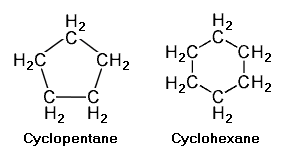Hydrocarbons: Difference between revisions
imported>Milton Beychok |
imported>Milton Beychok |
||
| Line 65: | Line 65: | ||
== Cyclic saturated hydrocarbons == | == Cyclic saturated hydrocarbons == | ||
Cyclic saturated hydrocarbons have a closed ring of carbon atoms in the shape of a polygon having the same number of vertices as the number of carbon atoms, with each carbon atom being bonded to two hydrogen atoms and to two other carbon atoms. They are referred to as '''cycloalkanes''', '''cycloparaffins''' or '''naphthenes'''. | Cyclic saturated hydrocarbons have a closed ring of carbon atoms in the shape of a polygon having the same number of vertices as the number of carbon atoms, with each carbon atom being bonded to two hydrogen atoms and to two other carbon atoms. They are referred to as '''cycloalkanes''', '''cycloparaffins''' or '''naphthenes'''. | ||
Cycloalkanes with a single ring of carbon atoms have a general formula of C<sub>n</sub>H<sub>2n</sub>. The adjacent image depicts two such single ring cycloalkanes, namely cyclopentane (C<sub>5</sub>H<sub>10</sub>) and cyclohexane (C<sub>6</sub>H<sub>12</sub>). | Cycloalkanes with a single ring of carbon atoms have a general formula of C<sub>n</sub>H<sub>2n</sub>. The adjacent image depicts two such single ring cycloalkanes, namely [[cyclopentane]] (C<sub>5</sub>H<sub>10</sub>) and [[cyclohexane]] (C<sub>6</sub>H<sub>12</sub>). | ||
Cycloalkanes may also have two | Cycloalkanes may also have two fused (i.e., conjoined) rings. For example, two cyclohexane rings may be fused, so that two of the carbon atoms are shared by each of the two rings, to form [[decalin]] (C<sub>10</sub>H<sub>18</sub>) which is referred to as a '''bicycloalkane'''. | ||
The general formula for cycloalkanes is C<sub>n</sub>H<sub>2(n+1-g)</sub> where g is the number of rings. | |||
== Aromatic hydrocarbons == | == Aromatic hydrocarbons == | ||
Revision as of 18:22, 22 March 2009
Hydrocarbons are a class of molecules that contain only carbon and hydrogen atoms. Some of them make very good fuels. Gasoline contains a mixture of hydrocarbons. Unsaturated hydrocarbons, which contain one or more double bonds, are useful chemicals for many reactions.
Linear saturated hydrocarbons
The simplest hydrocarbons are linear molecules in which each carbon atoms is bonded to two other carbons atoms, in a linear fashion, except for the carbon atoms at the ends, which are only bonded to one other carbon atom. Saturated hydrocarbon names generally end with the suffix "ane" which distinguishes them from unsaturated hydrocarbons, which end with the suffix "ene".
Linear saturated hydrocarbons are referred to as paraffins or alkanes. Their general formula is CnHn+2.
| Name | Formula | CnH2n+2 |
|---|---|---|
| Methane | CH4 | CH4 |
| Ethane | CH3–CH3 | C2H6 |
| Propane | CH3–CH2–CH3 | C3H8 |
| Butane | CH3–(CH2)2–CH3 | C4H10 |
| Pentane | CH3–(CH2)3–CH3 | C5H12 |
| Hexane | CH3–(CH2)4–CH3 | C6H14 |
| Heptane | CH3–(CH2)5–CH3 | C7H16 |
| Octane | CH3–(CH2)6–CH3 | C8H18 |
| Nonane | CH3–(CH2)7–CH3 | C9H20 |
| Decane | CH3–(CH2)8–CH3 | C10H22 |
Linear unsaturated hydrocarbons
Unsaturated hydrocarbons are useful precursor molecules for many reactions. Because they contain one or more double bonds, a large variety of chemical transformations are possible. Unsaturated hydrocarbons generally end with the "ene" suffix, although common names are sometimes used instead of the IUPAC designation. In addition, a numerical prefix is used to indicate the position of the double bond(s).
Linear unsaturated hydrocarbons containing a single double bond are referred to as olefins or alkenes. Their general formula is CnH2n.
| Name | Formula | CnH2n |
|---|---|---|
| Ethene | CH2=CH2 | C2H4 |
| Propene | CH2=CH-CH3 | C3H6 |
| 1-Butene | CH2=CH-CH2-CH3 | C4H8 |
| 2-Butene | CH3-CH=CH-CH3 | C4H8 |
| 1-Pentene | CH2=CH-(CH2)2-CH3 | C5H10 |
| 1-Hexene | CH2=CH-(CH2)3-CH3 | C6H12 |
Linear unsaturated hydrocarbons containing two double bonds are referred to as dienes, diolefins or alkadienes. Their general formula is CnH2(n-1) and some example dienes are:
- 1,2-Butadiene: CH2=C=CH-CH3 or C4H6
- 1,2-Pentadiene: CH2=C=CH-CH2-CH3 or C5H8
Linear unsaturated hydrocarbons containing a triple bond are referred to as alkynes. The simplest example is ethyne (acetylene): H-C≡C-H or C2H2
Cyclic saturated hydrocarbons
Cyclic saturated hydrocarbons have a closed ring of carbon atoms in the shape of a polygon having the same number of vertices as the number of carbon atoms, with each carbon atom being bonded to two hydrogen atoms and to two other carbon atoms. They are referred to as cycloalkanes, cycloparaffins or naphthenes.
Cycloalkanes with a single ring of carbon atoms have a general formula of CnH2n. The adjacent image depicts two such single ring cycloalkanes, namely cyclopentane (C5H10) and cyclohexane (C6H12).
Cycloalkanes may also have two fused (i.e., conjoined) rings. For example, two cyclohexane rings may be fused, so that two of the carbon atoms are shared by each of the two rings, to form decalin (C10H18) which is referred to as a bicycloalkane.
The general formula for cycloalkanes is CnH2(n+1-g) where g is the number of rings.
